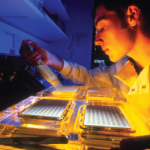In addition, she said that somatic mutations can be missed with WES and evidence increasingly shows the importance of these mutations for pathogenesis of disease, particularly late-onset disease.
Finally, she emphasized the need for collaboration to narrow down the list of candidate genes. “It is very important to work together when it comes to patients with rare inflammatory disease,” she said. “We should share data from our patients and collaborate in pursing new gene discoveries.”
Lung Involvement
As one example of collaboration in looking for rare variants associated with rheumatic diseases, Tony Shum, MD, assistant professor, Pulmonary & Critical Care, Cardiovascular Research Institute, University of California San Francisco, spoke on work underway to better understand the role of the lung in systemic autoimmunity.

Dr. Shum
He spoke on research in which he and his colleagues used WES to map rare variants in families with autoimmune arthritis with a dominant lung phenotype. They found that a rare variant, coatomer subunit alpha (COPA), was ubiquitously expressed in these patients. As a subunit of coat protein complex I (COPI), COPA enables protein transport between the Golgi and endoplasmic reticulum.3
Further research showed that mutations in the WD40 COPA domain cause autoimmune-associated lung and joint disease and identified a novel vesicular trafficking defect as the cause of autoimmunity. Their research also identified a novel molecular link between ER stress and the generation of immunity.
Prior to this research, no diseases were associated with COPA or COPI. As such, Dr. Shum said that this research points to the discovery and definition of a new syndrome, called the COPA syndrome, in which patients have pulmonary hemorrhage, interstitial lung disease and arthritis with or without autoantibodies.
Given the link between endoplasmic reticulum stress with both lung disease and the generation of immunity, further research is underway focusing on trying to understand the role of endoplasmic reticulum stress in the lung epithelium and how it may be involved more broadly in systemic autoimmunity.4,5
Dr. Shum said that this research supports emerging evidence on the importance of the lung “not only as a disease manifestation of autoimmunity but really as the tissue site in which autoimmunity might be proliferated or propagated.”6
“I think the way for clinicians to think about this is [as confirmation] of the need to tell their patients that they should not smoke, the rationale being that the lung may play a role in precipitating overall disease,” he said.

